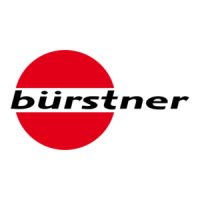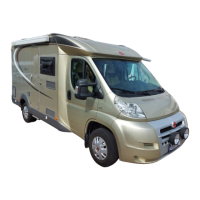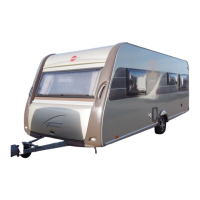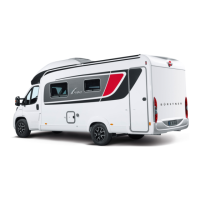Do you have a question about the Burstner motorhome and is the answer not in the manual?
General information about vehicle construction and safety instructions.
Advice on responsible waste disposal and environmental impact reduction.
Instructions for preventing fires and actions to take in case of fire.
General safety guidelines for vehicle operation and maintenance.
Essential safety measures for driving and parking the vehicle.
Guidelines and precautions for towing a trailer.
Safety instructions and procedures for the vehicle's gas system.
Safety precautions and general information regarding the electrical system.
Safety guidelines and procedures for operating the water system.
Information on the types and use of vehicle keys.
Notes on vehicle registration requirements in different countries.
Guidance on understanding and managing vehicle payload and weight limits.
Important considerations for towing a trailer safely and correctly.
Instructions for mounting and using a caravan coupling.
Operation and safety precautions for the vehicle's entrance step.
Instructions for securing the television before travelling.
Advice on securing sink and drain basin covers before driving.
Instructions for securely stowing additional parts and accessories.
Guidelines for using snow chains, including fitting and driving.
A checklist of essential checks before commencing a journey.
General advice and precautions for driving the motorhome.
Explanation of the parking distance control system's function and limitations.
Information on the reversing camera system and its operation.
Guidance on adjusting driving speed based on conditions and environment.
Instructions on brake system maintenance and safe braking techniques.
Safety regulations and proper use of seat belts for all occupants.
Guidelines for correctly securing children using appropriate restraint systems.
Instructions for adjusting and securing pilot seats for safe travel.
Information on adjusting headrests for comfort and safety.
Instructions for correctly applying the handbrake when parking.
Operation of the entrance step, including safety indicators.
Information on using ramps for vehicle levelling.
Guidelines for using wheel chocks when parking on inclines.
General instructions and types of steady legs for stabilising the vehicle.
Operation and safety instructions for electrical steady legs.
Information on connecting the vehicle to an external 230 V power supply.
Guidance on operating the refrigerator with different power sources.
Instructions for setting up and operating the satellite unit.
Operation of the Oyster automatic antenna alignment system.
Instructions for putting up and taking down the awning.
Instructions for opening and closing the vehicle's conversion door.
Procedures for opening and closing external flaps securely.
How to open and close furniture flaps and inner doors.
Location and operation of interior and exterior light switches.
Instructions for turning and shifting spotlights for optimal lighting.
Operation of the central lighting system with scene functions.
Instructions for positioning and storing the flat screen TV holder.
Importance of ventilation for air quality and preventing condensation.
Operation and care of windows, including blinds and insect screens.
Essential safety instructions and general information about the gas system.
Guidelines for transporting, securing, and handling gas bottles.
Step-by-step procedure for safely changing gas bottles.
Identification and function of gas isolator taps.
Instructions for connecting and using external gas appliances.
Operation of the automatic gas switching facility for safety.
Operation of the DuoControl automatic gas switching system.
Information on the gas alarm system's functions and potential false alarms.
Critical safety precautions for working with the vehicle's electrical system.
Definitions of key terms related to batteries and electrical systems.
Information about the vehicle's 12 V power system.
Function and types of the transformer/rectifier unit.
Operation and functions of the IT 96-2 control panel.
Operation and functions of the LT 510 control panel.
Instructions for operating and maintaining the EFOY fuel cell.
Information on the solar installation and charge regulator.
Guidelines for connecting to and using the 230 V external power supply.
General information and safety regarding vehicle appliances.
Operation and maintenance of the vehicle's heating system.
Operation of the Dometic and Telair air conditioning units.
Operation and maintenance of the boiler system.
Operation and safety for the gas cooker and grill.
Operating the refrigerator using different power sources and door locking.
General information on filling and operating the water system.
Details on water tank volumes and filler neck operation.
Instructions for draining and maintaining the waste water tank.
Step-by-step guide to filling and disinfecting the vehicle's water system.
Procedures for emptying and preparing the water system for frost protection.
Care and ventilation guidelines for the toilet compartment.
Operating and maintaining the vehicle's toilet.
Specific instructions for the Thetford C-402 toilet operation.
Guidelines for washing and maintaining the vehicle's exterior.
Recommendations for cleaning and maintaining the vehicle's interior.
Procedures for cleaning and disinfecting the water system.
Instructions for cleaning the extractor hood filter.
Maintenance procedures for Dometic and Telair air conditioning units.
Preparations and operational advice for winter conditions.
Checklists and procedures for vehicle lay-up and start-up.
Requirements for vehicle inspections and recommended intervals.
General guidelines for vehicle maintenance based on usage.
Lubrication and maintenance for doors and hinges.
Tips for extending living area battery life and maintenance.
Procedures for replacing fuel cell tank cartridges and refilling service fluid.
Checking and topping up heating fluid and bleeding the system.
Recommended operation and checks for the independent vehicle heater.
Instructions for replacing external light bulbs.
Instructions for replacing internal light bulbs.
Importance and location of the vehicle identification plate.
Information on vehicle stickers and obtaining replacements.
General advice on tyre maintenance, pressure, and wear.
Guidelines for selecting approved tyres based on vehicle specifications.
Explanation of tyre size designations and their meaning.
Advice on how to drive to minimize tyre wear and prevent damage.
Step-by-step instructions for changing a wheel safely.
Instructions for using the under-vehicle spare wheel support.
Instructions for removing the spare wheel from the rear garage support.
Importance of correct tyre pressure and how to check it.
Common faults related to the braking system and their remedies.
Troubleshooting for common electrical system faults and fuse issues.
Troubleshooting guide for the fuel cell system.
Common faults related to the gas system and recommended solutions.
Troubleshooting for Truma and Alde heater/boiler faults.
Troubleshooting for Dometic and Telair air conditioning units.
Troubleshooting for gas cooker and oven issues.
Troubleshooting for Dometic refrigerator faults.
Common problems with the water system and their remedies.
Troubleshooting for common body-related issues like hinges and seals.
Table of surplus weights for various special equipment options.
Ground plans illustrating the layout of components in different models.
Table of key vehicle dimensions (width, length, wheelbase, height).
Technical specifications for the vehicle's power supply systems.
Important information on traffic regulations in European countries.
Emergency contact numbers and breakdown service information for European countries.
Overview of speed limits and vehicle dimension regulations by country.
Specific traffic rule regarding low beam usage in Europe.
Guidelines for overnight stays outside designated camping areas.
Practical advice on gas bottle connections and supply in Europe.
Information on mandatory toll systems and formalities in European countries.
Protective measures for ensuring safety when staying overnight in the motorhome.
Advice and tips for a comfortable and safe winter camping experience.
Checklists to help prepare for journeys and ensure nothing is forgotten.
| Brand | Burstner |
|---|---|
| Model | motorhome |
| Category | Motorhomes |
| Language | English |












